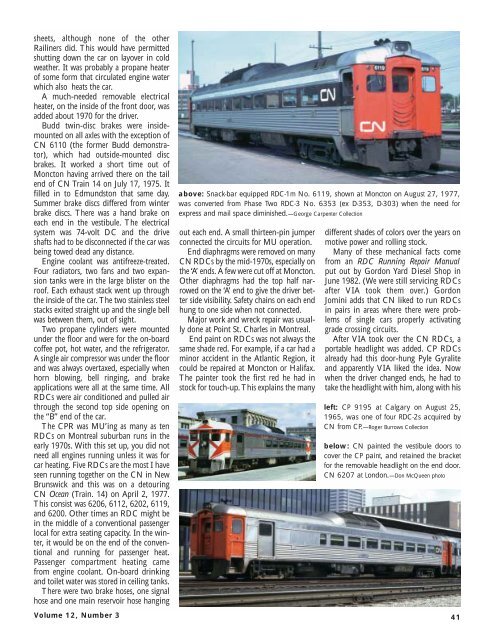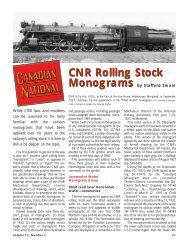CN LINES V12N3 - Canadian National Railways Historical Association
CN LINES V12N3 - Canadian National Railways Historical Association
CN LINES V12N3 - Canadian National Railways Historical Association
Create successful ePaper yourself
Turn your PDF publications into a flip-book with our unique Google optimized e-Paper software.
sheets, although none of the other<br />
Railiners did. This would have permitted<br />
shutting down the car on layover in cold<br />
weather. It was probably a propane heater<br />
of some form that circulated engine water<br />
which also heats the car.<br />
A much-needed removable electrical<br />
heater, on the inside of the front door, was<br />
added about 1970 for the driver.<br />
Budd twin-disc brakes were insidemounted<br />
on all axles with the exception of<br />
<strong>CN</strong> 6110 (the former Budd demonstrator),<br />
which had outside-mounted disc<br />
brakes. It worked a short time out of<br />
Moncton having arrived there on the tail<br />
end of <strong>CN</strong> Train 14 on July 17, 1975. It<br />
filled in to Edmundston that same day.<br />
Summer brake discs differed from winter<br />
brake discs. There was a hand brake on<br />
each end in the vestibule. The electrical<br />
system was 74-volt DC and the drive<br />
shafts had to be disconnected if the car was<br />
being towed dead any distance.<br />
Engine coolant was antifreeze-treated.<br />
Four radiators, two fans and two expansion<br />
tanks were in the large blister on the<br />
roof. Each exhaust stack went up through<br />
the inside of the car. The two stainless steel<br />
stacks exited straight up and the single bell<br />
was between them, out of sight.<br />
Two propane cylinders were mounted<br />
under the floor and were for the on-board<br />
coffee pot, hot water, and the refrigerator.<br />
A single air compressor was under the floor<br />
and was always overtaxed, especially when<br />
horn blowing, bell ringing, and brake<br />
applications were all at the same time. All<br />
RDCs were air conditioned and pulled air<br />
through the second top side opening on<br />
the “B” end of the car.<br />
The CPR was MU’ing as many as ten<br />
RDCs on Montreal suburban runs in the<br />
early 1970s. With this set up, you did not<br />
need all engines running unless it was for<br />
car heating. Five RDCs are the most I have<br />
seen running together on the <strong>CN</strong> in New<br />
Brunswick and this was on a detouring<br />
<strong>CN</strong> Ocean (Train. 14) on April 2, 1977.<br />
This consist was 6206, 6112, 6202, 6119,<br />
and 6200. Other times an RDC might be<br />
in the middle of a conventional passenger<br />
local for extra seating capacity. In the winter,<br />
it would be on the end of the conventional<br />
and running for passenger heat.<br />
Passenger compartment heating came<br />
from engine coolant. On-board drinking<br />
and toilet water was stored in ceiling tanks.<br />
There were two brake hoses, one signal<br />
hose and one main reservoir hose hanging<br />
above: Snack-bar equipped RDC-1m No. 6119, shown at Moncton on August 27, 1977,<br />
was converted from Phase Two RDC-3 No. 6353 (ex D-353, D-303) when the need for<br />
express and mail space diminished.—George Carpenter Collection<br />
out each end. A small thirteen-pin jumper<br />
connected the circuits for MU operation.<br />
End diaphragms were removed on many<br />
<strong>CN</strong> RDCs by the mid-1970s, especially on<br />
the ‘A’ ends. A few were cut off at Moncton.<br />
Other diaphragms had the top half narrowed<br />
on the ‘A’ end to give the driver better<br />
side visibility. Safety chains on each end<br />
hung to one side when not connected.<br />
Major work and wreck repair was usually<br />
done at Point St. Charles in Montreal.<br />
End paint on RDCs was not always the<br />
same shade red. For example, if a car had a<br />
minor accident in the Atlantic Region, it<br />
could be repaired at Moncton or Halifax.<br />
The painter took the first red he had in<br />
stock for touch-up. This explains the many<br />
different shades of colors over the years on<br />
motive power and rolling stock.<br />
Many of these mechanical facts come<br />
from an RDC Running Repair Manual<br />
put out by Gordon Yard Diesel Shop in<br />
June 1982. (We were still servicing RDCs<br />
after VIA took them over.) Gordon<br />
Jomini adds that <strong>CN</strong> liked to run RDCs<br />
in pairs in areas where there were problems<br />
of single cars properly activating<br />
grade crossing circuits.<br />
After VIA took over the <strong>CN</strong> RDCs, a<br />
portable headlight was added. CP RDCs<br />
already had this door-hung Pyle Gyralite<br />
and apparently VIA liked the idea. Now<br />
when the driver changed ends, he had to<br />
take the headlight with him, along with his<br />
left: CP 9195 at Calgary on August 25,<br />
1965, was one of four RDC-2s acquired by<br />
<strong>CN</strong> from CP.—Roger Burrows Collection<br />
below: <strong>CN</strong> painted the vestibule doors to<br />
cover the CP paint, and retained the bracket<br />
for the removable headlight on the end door.<br />
<strong>CN</strong> 6207 at London.—Don McQueen photo<br />
Volume 12, Number 3 41



